DMCA PROTECTED AND MONITORED
© COPYRIGHT – ALL RIGHTS RESERVED. This site is protected and monitored by DMCA.COM - ANY UNAUTHORIZED Reproduction, Duplication, Distribution of any kind is STRICTLY PROHIBITED. All original content is created by the website owner, Barron Shepherd, including but not limited to text, design, code, images, photographs and videos are considered to be the Intellectual Property of the website owner, Barron Shepherd, whether copyrighted or not, and are protected by DMCA Protection Services using the Digital Millennium Copyright Act Title 17 Chapter 512 (c)(3). Direct linking, reproduction or re-publication of this content is prohibited without permission. Under 17 U.S.C section 101 et seq. those who violate the DMCA could be liable for statutory damages as high as 150,000.00 as set forth in section 504(c)(2) therein.
Wednesday, September 30, 2009
JUDO: SHIME WAZA
We worked on different shime waza (choking techniques). Shimewaza is probably the most difficult area of judo to master. Few judo practitioners will ever attain total mastery of shimewaza. The majority of shimewaza techniques require compression of the carotid artery. Also shimewaza attacks must be precise especially if attacking an experienced player.
The basis for all chokes/strangles is to attempt to render the opponent unconscious. A good strangulation hold should render the opponent unconsciousness without injury or significant pain in a matter of seconds regardless of whom the opponent is. The most basic requirements for applying such an effective strangulation are:
* Make sure your own body always has complete freedom of action so that you are in the best position for the technique you intend to use and you are flexible enough to be able to respond to your opponent's attempts to escape. Your position should be stable so that in applying the technique you can use your entire body.
* Lead your opponent into a position in which it is most difficult to put up resistance, and control all of his or her actions. Your opponent must be unstable and under your control as much as possible. Very often this means stretching out your opponent's body backwards.
* Train your hands to get an accurate hold the minute you begin a technique, make your choke work in a very brief time, and once you begin the pressure refrain from continually releasing to adjust your position. Your techniques will have much greater effect if you are firmly resolved not to let your opponent get away but to continue until the end without slackening. Constancy of pressure, rather than extreme force, is what is called for. Excessive reliance on strength would indicate a defect in the technique since very little pressure is needed to compress an artery and render a person unconscious.
Tuesday, September 29, 2009
JUDO: SOLO DRILLS
Take a bicycle tire inner tube , and slice it so that you essentially have a long strip of rubber that you can wrap around the tree, and hold the ends in your hands.
Approximate your preferred grip's hand positioning (lapel and cuff, double lapel, etc), and practice entering as if you were performing specific throws, whilst pulling in the appropriate manner on the inner tube.
Tie your Gi belt at about waist height around a pillar/post/tree of your choice. If it slips down, a bit of duct tape will do to either hold the belt in place, or replace it for the task.
Make sure that your belt is at the correct height in relation to your opponent's (the belt/tape around the tree/post/pillar), and that your weight is distributed correctly. Think about kuzushi as you pull on the arms. Think about your foot placement, positioning, and agility.
Can be done as static Uchikomi, or to breakdown an aspect of the technique.
Obviously not a replacement for actual uchikomi or training with a partner, but a good drill nonetheless.
An introduction to using bicycle innertubes to practice judo techniques, develop form, and build strength.
This is an old video of a Judoka training by using an old bicycle inner tube.
Monday, September 28, 2009
JUDO: DRILLING HARAI GOSHI
Tonight's practice we worked on a Harai Goshi. Personally Harai Goshi isnt one of my favorite techniques. Harai Goshi usually works better for taller judoka. I am only 5'10" my personal favorite throws are Seoi Nage, Tai Otoshi and I like alot of the Ashi Waza techniques. But working to improve your weaker or least liked throws is goo
Harai goshi is one of the original 40 throws of Judo as developed by Kano Jigoro. It belongs to the second group of the traditional throwing list in the Gokyo no waza of the Kodokan Judo. It is also part of the current 67 Throws of Kodokan Judo, and classified as a hip technique (koshiwaza). Russian Prime Minister and former President Vladimir Putin is known for his Harai Goshi.
Starting from a right-side grip:
- Simultaneously: pull the opponent’s sleeve up and towards you with your left hand, pull in with your right arm (gripping back of collar, lapel, or belt), and step your right foot to the front corner of their right foot.
- Step your left foot behind your right foot - right between their feet. Bend your knees. Stay low. Stay on the balls of your feet. Make contact with the side of your hip into their hip or upper thigh.
- Simultaneously: pivot on the ball of your left foot, lift with your left leg, stretch your right leg to the outside of their right thigh while swinging it up to the ceiling, and twist your body to the left (you’ll end up standing on your left toes with your body and right leg horizontal).
- The opponent will fly over your right shoulder.
- Keep the grip on the opponent’s sleeve and pull up slightly as they hit the mat. This allows you to maintain control and softens the impact for your partner.
Kuzushi
As with every judo takedown, kuzushi (or breaking the balance) is the most important element to master. When the opponent is off balance, they’ll be easier to throw, which means you’ll spend less energy achieving a stronger throw. For harai goshi, the bulk of the kuzushi comes from giving the opponent’s sleeve a hard pull up and towards you. This will cause them to move forwards and up on their toes - the perfect position for you to get your hips right under their centre of gravity.
Attack With a Low Center of Gravity
After kuzushi, the most important element of harai goshi is attacking with a low center of gravity - lower than your opponent’s. When this is done properly, almost all of the throw’s power comes from the legs rather than the back and upper body. That means a more powerful throw that requires less effort and reduces the risk of injury.
Leg Position in Harai Goshi Blocks the Opponent’s Counter
One of the counters to ogoshi is to simply jump around the opponent and get back to facing them. By getting off of and away from their hip, you take yourself out of the danger zone. The beauty of harai goshi is that the leg is positioned outside of the opponent’s hip, making it much more difficult for them to jump around and get off of your hip.
Some have asked me why I am doing this blog. Rather unexpectedly it has become quite clear to me that my blog is definitely becoming an aide in my training. As a martial artist and competitor I know I make mistakes and the blog is one way That allows me to address them and instill proper technique by writing it down in words It helps in my retention of existing skill sets and new skill sets.
JUDO: GRIPS, GRIPS, GRIPS
Know your throws and look for the grips that are the most effective with your throws. Ideally you want a set of different grips which are comfortable and effective for you. So sort out what your favorite/most effective techniques are and what grip you need for them, then work for it.
Now that we know what grip we want, we need to get it on our opponent. Don't let your opponent dictate grips. If you ever feel uncomfortable with an opponent's grip, get out of it. Ripping it off is usually the first option. You might attempt a lapel/overgrip/collar grip because that's where the attack is going to come from. Grip the sleeve of the opponent's gripping hand with both hands and push down in a sharp motion. If it doesn't immediately break off keep pushing down in a stuttery kind of rhythm until it comes off. Another method of breaking off an overhead grip is to grab the opponent's armpit (on the side they're overgripping) and quickly stiffen your arm while rotating into them and shrugging your shoulder. This will either pop off the grip or weaken it enough that you can reach up and rip it off.
The one thing people tend to do is take the sleeve first. This gives your opponent a handle on you, since they can now easily grip your sleeve and control that arm. Work on your lapel/collar/overgrip/undehook hand first. Use the opposite hand to cross grip and pull your opponent in to make it easier to catch the grip you want if you're going for an over grip or underhook. Once you've got that hand set the sleeve is easy, just reach out and grab it.
You need two hands to control both sides off your opponent. Letting go with one gives them free reign on the one side and you can't block or control them. Be aware when you're both sunk in gripping you need to be doing something with a hand if you're letting go, be it an attack or a change to another girp. Make your opponent react to it so they don't have time to attack. The ideal time to attack is when your opponent only has one hand on you.
Friday, September 25, 2009
JUDO: Looking back
 ections of Judo was back in the 70’s around "78" or "79" I had seen the movie “Breaking Point” starring actor Bo Svenson. "Breaking Point" was my first exposure to martial arts on screen. In "Breaking Point" he played a judo instructor who witnesses a murder carried out by the mob and he and his family are entered into a witness relocation program. There were some memorable fight scenes in the movie that impressed this young 12 year old boy.
ections of Judo was back in the 70’s around "78" or "79" I had seen the movie “Breaking Point” starring actor Bo Svenson. "Breaking Point" was my first exposure to martial arts on screen. In "Breaking Point" he played a judo instructor who witnesses a murder carried out by the mob and he and his family are entered into a witness relocation program. There were some memorable fight scenes in the movie that impressed this young 12 year old boy.Another movie which made an impression was "Judo's Gentle Tiger" and also known as "The Year of the Gentle Tiger". A forerunner to "The Karate Kid", it was shot in the late 1970s, and was later broadcast as a NBC daytime program in 1979. But it was Bo Svenson’s movie "Breaking Point" that was the catalyst for my interest in judo and other martial arts. All other influences would come and go, but, Bo Svenson's would stay and re-inspire years and years later.
By the age of 14, I was in a karate/jiujitsu class which I stayed with for years but the impression Bo Svenson made would linger for a lot of years. My family did not share my enthusiasm for the martial arts. Most of my inspirations came from people I did not know nor did they know me. I guess like alot of kids my inspirations came from the heroes portrayed on the silver screen and T.V. by actors like Bo Svenson.
Recollecting my boyhood movie memories of judo, in 1991 at the age of 26, I would step into a judo class for the first time. Judo was like no other style I had trained in and I was assured of two things by the Judo instructor; Rank would nt come easy nor would it come fast. I was told by the instructor that this would be an endeavor that would take years of hard work. That the lessons learned in judo corresponded with life and as I found out, life somehow made sense on the judo mat.
As I look back, my judo experience was like developing a taste for beer, at first it was unpleasant but after awhile you got used to it and then eventually began to enjoy it. This however would take years of showing up to class. Alot of times I would ask myself, "what am I doing here?" Being too stubborn to quit after several years I attained brown belt. It was nt until brown belt that a love for judo developed.
Finally in 1998, I tested and was awarded shodan. I had never taken as much pride in achieving something as I did when I had achieved my shodan rank in Judo. I hold higher ranks in other styles but the rank I have been most proud of are the shodan and nidan ranks I attained in judo.

Then in 2006 I was awarded nidan and had seen Bo Svenson's movie "Breaking Point" again after alot of years. After 2006 work and other endeavors had taken me away from judo. I was involved also with other martial arts and all of these things just took up too much time. Some time after, I was able to contact Mr. Svenson and had asked him of his judo experience and if he was still training at which point he said he was nt and that it was too bad that he was nt involved any longer.
By 2009 I had become disillusioned with the politics of the other martial arts that had taken up so much of my time. I began to distance myself from karate, jiujitsu and running a dojo. Tired of politics, tired of teaching, maybe I was just plain tired of everything. I dont really know. I do know I wasnt happy and no longer found enjoyment in training or teaching. I was just not motivated any longer and felt that there was something that I was missing but just couldnt put my finger on it. So, I closed my dojo and walked away.
I had not stepped foot in a judo dojo in over two years and had closed my dojo earlier this year and was no longer teaching or training. Then a few months ago, out of nowhere Bo Svenson contacted me. He wrote "Nearly a year ago you asked if I was still involved in judo. At the time I wasn't. I am now. This weekend I am competing in the the USA Judo National Championships. I'm THRILLED to be back in the sport! Hope all is well with you."
My childhood hero had managed to inspire me again, but this time I was nt a boy of 12 but a man of 44. Alot of years had gone past since I first saw him play that role of judo instructor and now those few words had lifted my spirits and moved me in a long lost familar direction. Not only had his words affected me but his actions as well, as he stepped back on the mat to compete as he had told me he would.
Memories of judo and the people I trained with, my old sensei, the sounds of judoka hitting the mat, practicing ukemi, getting thrown and the purity of judo itself ran thru my mind. I guess I went back to th
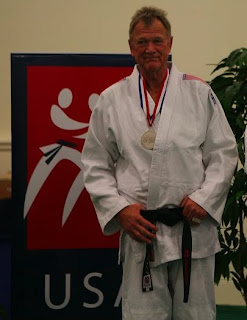 e beginning, the first influence, the first impressions made on a young boy so long ago. A distant unknowing role model whose few words reaffirmed the purity of a martial art that I had so desperatly needed and couldnt find. A once extinguished fire trying to spark and rekindle.
e beginning, the first influence, the first impressions made on a young boy so long ago. A distant unknowing role model whose few words reaffirmed the purity of a martial art that I had so desperatly needed and couldnt find. A once extinguished fire trying to spark and rekindle.I am back in Judo but not as an instructor but as a simple student, getting back into the learning process, the developmental process not only of a martial artist or a competitior but a human being as well. The rebirth of a spirit. On the other side of our great country Bo Svenson is busy with movies and Judo training and teaching, still inspiring me as he had done so many years ago from a distance. Yep, life always made since on the judo mat, a point reinterrated by a humble hero of the silver screen in a few written words.
http://barronsjudopage.blogspot.com/2009/08/judo-actor-bo-svenson-competes-in-usa.html
Sunday, September 20, 2009
JUDO
"The Combatants, one is in white, the other in blue, each circles the other. Their hands darting in swiftly, like a boxer’s jab, for their grip, a handful of collar and or sleeve. They break off, then re-engage, and begin a violent whirlwind of motion, a dazzling dance that moves in every conceivable direction around the mat with lightening speed, fury and herculean effort. Bodies twist and collide, somersault thru the air, stumble and crash, as each tries to throw other to the canvas with all the force he can unleash. One’s assertion written in the air with his opponent’s flying body with a vehement desire to score an ippon, the highest score inflicting a symbolic death."
Friday, September 18, 2009
JUDO AS SELF DEFENSE
In addition to the above, Judo's background in traditional Jujitsu combined with its police and military applications, has resulted in kata specifically designed to teach technical principles for self-defense: Kime No Kata (Forms of Decision) and Kodokan Goshin Jutsu (Forms of Self Defense).
Various aspects of Judo principles and training methods promote attributes and skills helpful in self-defense:
- Training with full power and speed against fully-resisting opponents: builds speed, stamina, strength, and tenacity.
- Body and mental conditioning by repeatedly being thrown with significant force.
- Training in safe methods to take falls.
- Ability to accurately and quickly use balance, distance, and timing against skilled opponents in fully-resistive sparring. Judo practitioners are experts in controlling their opponent's balance whilst maintaining their own.
- Sports Judo rules emphasize rapid transition to pins or submissions after a take-down, which builds skills in explosive use of chokes and locks in self-defense situations.
- Emphasis in controlling one's opponent during throws allow a practitioner to dictate the angle, direction, and force with which his or her opponent lands on the ground. The consequences could be gentle or lethal, depending on the Judo practitioner's intentions.
Wednesday, September 16, 2009
JUDO: Drilling combinations
When it comes to combinations there are basically two kinds of combination techniques in judo, renzoku-waza and renraku-waza. Renzoku-waza is a combination of two or more techniques in the same direction, where the first technique begins to break the opponent's balance and the second technique finishes the job. An example of this kind of combination would be uchimata into harai-goshi, where both attacks take the opponent to his left front corner.
The second kind of combination renraku-waza is a reaction combination, where the first attack provokes a strong defensive reaction, inviting the attacker to switch direction to exploit this defensive effort. For example if you attack with o-uchi-gari, causing the opponent to step back and push off with his arms, you then switches to ippon seoi-nage exploiting his opponent's defensive push to throw him forwards. The switch of direction might just as easily be from left to right as from rear to front. One can attack with right uchimata which the opponent must block strongly to prevent himself from being thrown; You release your left-hand grip on the opponents sleeve and spin under the opponent's left arm with left seoi-nage.
At the higher levels the first attack may become just a threatening feint designed to provoke a defensive twitch, but for the first attack to provoke such a reaction it has to feel dangerous. Your opponent has to be convinced on a subconscious level that if he does not react strongly he will be thrown. Tori’s job then is to convince the opponent, through his grip, footwork and body movements that he intends to do a particular throw and the opponent must be made to react.
My body was no longer sore after all I had a week off of training due to labor day weekend and so we had no practice on Monday of last week since it was labor day. So I was feeling pretty good. I knew in the back of my mind once things got back to normal the soreness would be back so I took alot of comfort in the fact that I wasn't sore.
Watching the instructor of the class it was evident he knew his stuff when it comes to high level judo play. This reassured me that I was in the right place and during training there was talk of upcoming tournaments. I wondered if I would be ready for one of them. My intention is not to just compete, but to win. Anything less would be unacceptable.
After we finished with the combinations, we spent some time on working on techniques that some of the lower belts would be tested on for their next rank on Sunday.
Friday, September 11, 2009
Presidential Judo: Vladimir Putin
by Tom Ross
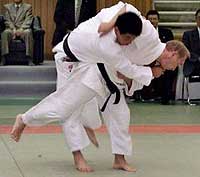 He may head of one of the world's elite superpowers, but to his fellow judo club members Russian President Vladimir Putin is best known for his wicked sweeping leg throw (Haraigoshi).
He may head of one of the world's elite superpowers, but to his fellow judo club members Russian President Vladimir Putin is best known for his wicked sweeping leg throw (Haraigoshi).
Although it is little known in the west, Putin is an avid student of judo -- the Japanese art in which students compete to throw their opponents or defeat them on the ground with grappling techniques, such as immobilizations, chokes and submission arm locks.
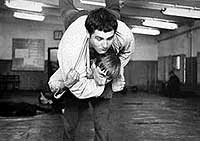 Putin began studying judo at age 14 and has been studying ever since. During his competitive career, among his many victories Putin placed third place in the Russian Junior Nationals and was Leningrad Seniors Champion. He is now President of the same club where he began, St. Petersburg's Yawara Judo Club.
Putin began studying judo at age 14 and has been studying ever since. During his competitive career, among his many victories Putin placed third place in the Russian Junior Nationals and was Leningrad Seniors Champion. He is now President of the same club where he began, St. Petersburg's Yawara Judo Club.
Several years ago, following an official state visit to Tokyo, Japan, Putin was a guest at the famous Kodokan headquarters of judo. In attendance were many officials including Japanese Prime Minister Mori. Yukimitsu Kano, the grandson of Kodokan Judo's founder Jigoro Kano said, "President Putin started Judo when he was very young, and has continued practice until now. He had a wish to visit the Kodokan institute. We are very happy to have him and welcome him as a judo member."
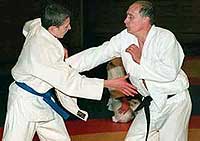 Following demonstrations of the art, Putin showed his own skills of throwing and grappling. Assisted by a Kodokan instructor, Mukai, Putin demonstrated a variety of leg sweeps, shoulder, and backward sacrificing throws plus two techniques favored by smaller men facing larger opponents -- an inner leg throw that dumps the opponent backward and the basic hip throw that introduces most students to the art. He also performed ground immobilization techniques. Afterwards Putin's assistant, Mukai said, said that President Putin's technique was very good.
Following demonstrations of the art, Putin showed his own skills of throwing and grappling. Assisted by a Kodokan instructor, Mukai, Putin demonstrated a variety of leg sweeps, shoulder, and backward sacrificing throws plus two techniques favored by smaller men facing larger opponents -- an inner leg throw that dumps the opponent backward and the basic hip throw that introduces most students to the art. He also performed ground immobilization techniques. Afterwards Putin's assistant, Mukai said, said that President Putin's technique was very good.
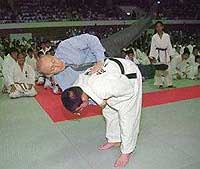 Putin was then presented with flowers by a young lady. And to the delight of the audience Putin permitted her to throw him. He was officially awarded a coveted sixth degree black belt.
Putin was then presented with flowers by a young lady. And to the delight of the audience Putin permitted her to throw him. He was officially awarded a coveted sixth degree black belt.
Not since US President Teddy Roosevelt has a world leader been associated with judo or other martial arts. Roosevelt had been involved in both boxing and wrestling. After witnessing a demonstration of judo by Yoshiaka Yamashita against a wrestler at the White House, Roosevelt began studying the art under this teacher, eventually becoming the first American to achieve the rank of brown belt. While Roosevelt may be the first modern day head of state to actively practice in the martial arts, Putin is certainly the first to achieve an advanced rank in martial arts.
Photos courtesy President Vladimir Putin website and reproduced with permission: www.vladimirputin.4u.ru
About the Author:
Tom Ross is a retired NYC Correction Officer who specialized in the Handling of Security Risk group prisoners. A Yudansha in Shorinjiryu Kenzenkai Karatedo (an Offshoot of the Shorinjiryu Kenkokan founded by Masayoshi Hisataka), he also spent six years studying Jujutsu (classical, modern and Brazilian). Possessing an avid interest in the history of martial arts and traditions he currently serves as the Research Coordinator for FightingArts.com as well as moderating its Martial Arts Talk forum. He additionally serves as the moderator of the Sabaki List (which is dedicated to various martial artists and full contact stylists) and is a member of the International Hoplology Society.
Wednesday, September 2, 2009
Judo: Nage waza and more uchikomi drills
I wondered again, how long it was going to take for everything to at least feel normal again. My timing, footwork and coordination was indeed off and I found myself struggling just get my steps right.
We then moved our opponent back ward moving into three uchikomis and then on the fourth a throw. We ended the drill with moving yet another direction for three uchikomis and then on the fourth a throw. We kept this multi directional drill up for 15 minutes then rested. We repeated this three times. This type of drill was done at the Olympic Training Center in Colorado springs.
I felt that felt as if I was moving slow with no fluidity at all. I almost felt like a fish out of water except for the fact that I knew what to do but just couldn't seem to get my body working in unison with my mind.
We ended with an anaerobic uchikomi drill in which we again partnered up and one would attempt 10 uchikomis sprint across the mat touch the edge and sprint back to your partner and do 10 more and then run the sprint again. We repeated this for 5 sets completing 50 uchikomi.
I had managed to work up a good sweat tonight and again felt like an old wet sack of sore bones on my way home. As much as it was hard work, I was just as anxious for another practice and in a hurry for the rust to wear off and disgusted with my performance despite the encouragement I had gotten from some of the guys at the dojo.
